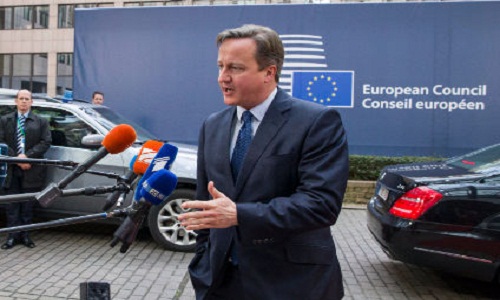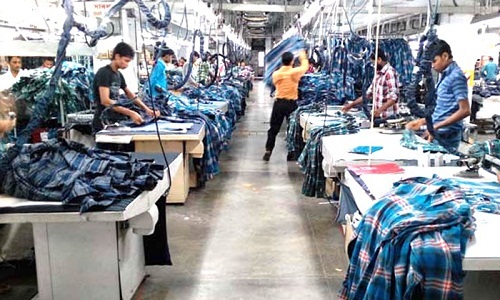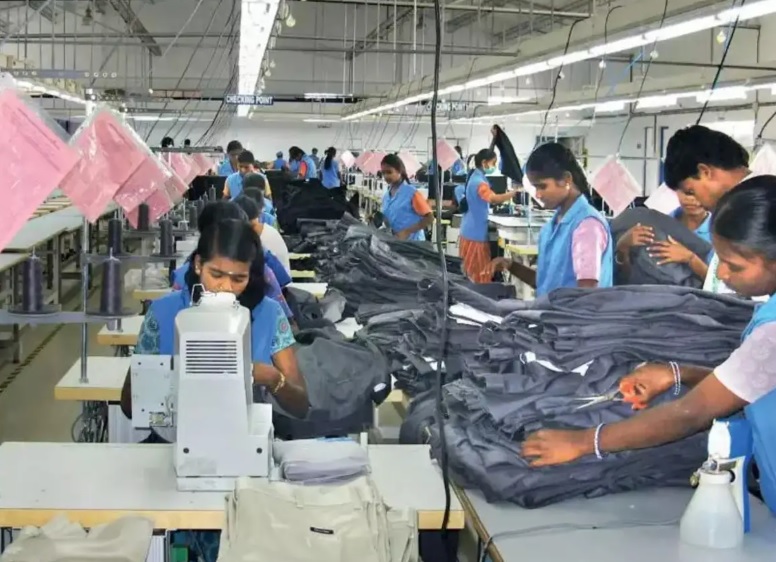FW
The recent auction initiated by China on reserve cotton to fuel domestic mill demand is set to impact India’s spun yarn production.
The offtake by Chinese mills under the ongoing reserve cotton auctions in China has affected India’s cotton and cotton yarn exports.
In FY 2016, India’s spun yarn production grew at the slowest pace of about 3.2 per cent in the last four years. This slow pace of growth in spun yarn production has been driven by factors like tepid domestic consumption and limited growth in exports.
The Chinese move of cotton reserve auction could also impact margins of Indian spinning mills going ahead.
Given the concerns on yarn export prospects due to the expected improvement in mill use in China, and expectations of firm domestic cotton prices in the near term, under tightened cotton availability, the contribution margins of Indian spinning mills can come under further pressure in the coming quarters.
Despite the sluggish domestic demand, the weakness in the Indian currency during the fourth quarter of 2016 and the resulting improvement in export realisations in rupee terms drove up domestic yarn prices.
The increase in yarn prices was also driven by the impact of firm cotton prices in the backdrop of tightened cotton availability. As the increase in yarn prices was higher than the increase in cotton prices, the average contribution margin in the fourth quarter of 2016 was higher by five per cent on a quarter-on-quarter basis, though lower by roughly one per cent on a year-on-year basis.
Increasing interest of Indian spinning mill owners in Pakistani cotton has accelerated the local market. July will be a very crucial month in connection with cotton as there is an increasing trend in prices in the Indian cotton market. The price of the benchmark Shankar-6 variety of Indian cotton has been further increased by Rs 200 to Rs 40,500.
The remaining stock of old crop is not more than 50,000 bales while expected production for the month of July is 1,10,000 bales so the total available quantity will be 1,60,000 bales against the required quantity of 4,10,000 bales for the month.
The Karachi Cotton Association, however, reduced its spot by Rs 50 to Rs 5,550 per maund.
Prices in both Indian and Pakistani markets are being increased and one can easily assess the future of cotton while keeping in view the increasing trend in its prices.
India is the world’s second largest cotton producer but Indian spinning mill owners are now searching for the commodity in markets all over the world.
On the global front, the referendum regarding the disintegration of the UK from the European Union kept the future deals of the New York cotton market in pressure; however, prices in the Indian cotton market are being increased with each passing day.
In the wake of hectic lobbying from different stakeholders, the Bangladeshi government is likely to bring down the tax at source on export from the proposed 1.50% for the next fiscal year 2016-17.
While presenting the budget for FY’16-17, Finance minister AMA Muhith had proposed to hike the tax at source on exports, including readymade garment sector by 1.50%. The minister proposed to set the tax rate at 1.5% from the existing 0.60% for the upcoming fiscal year.
Since then, considering the interest of exporters, leading business chambers and trade bodies have been pressing the government to reduce the tax rate or keep it unchanged at 0.60% for the next fiscal year.
The proposed hike on tax at source will not only cast shadow on new investment but also lead the sector to face tough competitions as the prices of product would go up further, they argued.
If the proposed tax at source is implemented, it will increase production cost and reduce competitiveness in the global market, they said demanding to set source tax rate at 0.60%.
Meanwhile, the Federation of Bangladesh Chambers of Commerce and Industry (FBCCI), with a revised budget proposal, requested the National Board of Revenue (NBR) to reduce the proposed tax at source on export proceeds to 0.60% from the proposed 1.5%.
As the rate is not yet finalised, Muhith may revise down the tax rate just before passage of the finance bill by the parliament on June 29, ministry officials said.
From July to April of FY16, the revenue authorities had collected over Tk1,300 crore as tax at source from the export-oriented industries.
The government was supposed to get Tk4000 crore from the sector due to the hike in tax at source on the export, said an official quoting NBR projection. “If reduced, it will have major impact on revenue collection,” he added.
According to officials in the finance ministry, the proposed tax rate may come down due to huge resistance by different quarters but the rate will not be set below 1% considering the revenue prospects.
Earlier in FY’16, the government had proposed to increase the tax at source on export proceeds to 1% but later it was reduced to 0.60% following protests, mainly from the clothing product exporters.
According to the market insiders, local producers will lose competitive edge while the competitors will become stronger as they are getting policy support from their respective governments.
Bangladesh is likely to reduce the tax at source on export from the proposed 1.50 per cent for the next fiscal year 2016-17 in the wake of hectic lobbying from different stakeholders.
The proposed tax rate may come down due to huge resistance by different quarters but the rate will not be set below one per cent considering the revenue prospects.
Earlier, in FY’16, there was a proposal to increase the tax at source on export proceeds to one per cent, but later it was reduced to 0.60 per cent, following protests, mainly from clothing exporters.
The industry feels if the proposed tax at source is implemented, it will increase production cost and reduce competitiveness in the global market. The proposed hike on tax at source, it’s felt, will not only cast a shadow on new investments but also lead the sector to face tough competition as the prices of products would go up further.
Local producers feel they will lose their competitive edge while competitors will become stronger.
Leading business chambers and trade bodies have been pressing for a reduction in the tax rate or keeping it unchanged at 0.60 per cent for the next fiscal year considering the interest of exporters.
"According to economists, post Brexit, the British pound is expected to continue tumbling, quickly leading to higher prices. Businesses worried about the impact of Brexit will at best delay investments – and at worst, start moving jobs elsewhere. Even Brexit's strongest advocates have admitted some economic stuttering is likely at first – and, as Britain is the EU's biggest export customer after China, any slowdown here will slow the rest of Europe."

Brexit will make Britain’s politics and economy volatile and extraordinarily uncertain for some time. However, the United Kingdom will no longer be bound by the European VAT rules; the weaker pound may cause inflation; the local economy can shift towards other areas and all these things make it very hard to predict a possible Brexit impact.
According to economists, post Brexit, the British pound is expected to continue tumbling, quickly leading to higher prices. Businesses worried about the impact of Brexit will at best delay investments – and at worst, start moving jobs elsewhere. Even Brexit's strongest advocates have admitted some economic stuttering is likely at first – and, as Britain is the EU's biggest export customer after China, any slowdown here will slow the rest of Europe.

During that period of uncertainty, apparel brands and retailers need to make their case clearly – something they've been pretty hopeless at recently, on both sides of the Atlantic.
Most Brexit supporters expected to lose, when Britain's EU referendum was first announced. In mid-May, 'Leave' started to pull ahead of 'Remain.' That surge of resentment coincided with growing complaints about prominent British apparel retailers.
Low wages and tyrannical management at Sports Direct's Shirebrook warehouse in Derbyshire summarise Britain's EU tangle. The area has been devastated since the UK government closed its coalmines in the 1990s, and while growth in Sports Direct's e-commerce business has meant the workforce has grown tenfold, the boom has also pulled in thousands of East European migrants – whose low pay is topped up by British tax subsidies. Their arrival also put strains on many of the town's resources.
Brexit advocates claim stronger trade links with countries in Asia and the Americas will eventually make Britain better off outside the EU.
Apparel retailing stands to gain

World's largest apparel retailers and brands have seen profitability falling lately. As a result, it has tried putting more emphasis on promoting sales to developing countries – but often that has simply depressed profit further.
US apparel importers continue to push for ratifying the proposed Trans-Pacific Partnership (TPP). But none have provided any evidence that US voters will see a direct benefit in terms of greater job opportunities or lower prices. Lobbyists just claim that US apparel importers' profits rely on the TPP. Almost every UK retailer believed leaving the EU would be a step backwards. Europe gives them opportunities they don't want to lose.
Now with Brexit, the British government will want lots of international agreements it can present as ‘trade deals.’ Every country in Asia would love a deal that lets it sell clothes duty-free to Britain without easier access to their own markets for UK products. Which is precisely the kind of deal countries like Japan and Switzerland have signed with India. British apparel retailing stands to gain a lot from post-Brexit Britain's taste for trade negotiations.
Impact on Europe
Experts say there are two areas the Brexit will hit Belgian companies the hardest when it comes to trade and retail: first, the exchange rate, because currency devaluation will make imported goods more expensive. At the same time, it will benefit British competitors. Immediately after the referendum's results were revealed, the pound dropped to its lowest level since 1985, compared to the dollar.
The second area is more of a long-term effect: If the United Kingdom is no longer part of a unified market, then it can create rules and impose tariffs that may slow trade. Likewise, the European Union can also harden its stance on the import of British goods. Plenty needs to be discussed between both sides before a clear impact can be seen. Considering the intensity of trade between the United Kingdom and the European Union, both trade groups will probably (need to) sit down and write down new deals.
It is far too early in the process to see which way these talks will go. Will the United Kingdom remain in the European Economic Area, like Norway and Iceland, or will it move towards the European Free Trade Association, like Switzerland? Maybe it will just create multi- or bilateral treaties with the United Kingdom or individual European countries? The UK's exit has to be pinpointed within the next two years, but there is no timeframe for any new commitments whatsoever.
What does this mean for Asia?
Already, policy makers in Japan, Korea and India are saying not much impact in terms of their respective countries' real economies. They're trying to reassure investors and to keep markets calm. It's true - a direct impact on Asian economies from Brexit is unlikely in the longer term.
As OCBC Bank's Wellian Wiranto said in a note to investors: As a percentage of GDP, exports to the UK range from 2-3 per cent for economies such as Hong Kong and Vietnam, to even lower (0.2-1 per cent) for most of the rest - including Indonesia and Malaysia.
But businesses in some major Asian economies, particularly India and Japan are likely to be hit.
Japan Inc. employs around 140,000 people in the UK and has about $59bn (£40bn) invested there. Big Japanese car manufacturers like Toyota have already said a Leave vote may lead to 10 per cent duties on UK-made cars being sold in the EU. Currently, Toyota exports almost 90 per cent of the cars it manufactures in the UK - and three quarters of those go to the EU.
Asian companies which have set up operations in the UK to gain access to EU markets will also have to reassess. Japanese electronics firm Hitachi, for one, has said it will rethink its UK operations in the event of a Brexit.
Over in India, the focus is on technology firms. Together, the UK and Europe account for over-a-quarter of the country's IT exports, worth around $30bn. In a statement, the Tata Group which has been operating in UK since 1907 said there are currently 19 independent Tata companies in the UK, with diverse businesses. It also said that ‘access to markets, and to a skilled workforce will remain important considerations.’
Certainly Asian business leaders are watching the process of how the UK transitions out of the EU very closely. If there is a material impact on EU economies, Asia won't escape unscathed.
China is also expected to suffer due to Brexit. The Chinese market didn’t reflect that overnight, falling by a marginal 1.3 per cent. Then again, investors all week were certain that the U.K. would remain a part of the EU.
The yuan still has ties to the dollar. As the dollar rises, the yuan rises. As the yuan rises, Chinese goods are less and less competitive. Chinese exports slow, manufacturing shrinks, layoffs are rife, unemployment escalates, imports decline, commodity prices fall and commodity economies crash. China falls into recession for reasons above mentioned. The U.S. falls into recession because the dollar is simply too strong.
And Europe, falls into recession because Brits - their currency crushed relative to the euro - can’t afford as much from Germany (hitting the German economy hard) and because of the loss of white-collar and manufacturing jobs that are soon to leave the U.K.
In short, the global economy is hit by Brexit, which will take a while to come out of it.
Textile mills and weaving units from different parts of Tamilnadu have displayed their products at a three-day event organised there by the Powerloom Development and Export Promotion Council along with the Regional Office of the Textile Commissioner.
With as many as 18 stalls, the business-to-business (b to b) meeting has companies from Palladam, Karumathampatti, Dindigul, Coimbatore and Erode displaying bed spreads, dress materials for men and women, aprons, shirts, towels, etc.
According to G. Kummaravel, assistant director at the Regional Office of the Textile Commissioner, this is an opportunity for hospitals, hotels, and educational institutions to select products and suppliers for bulk purchase. All the participants are direct manufacturers with 10 to 40 looms. They already supply products across the country and this is a platform for them to get new customers.
The Central Government has provided Rs. 10 lakh for the event and only a nominal amount is collected from the participants for the stall charges, according to Kummaravel.
Similar events were held in Coimbatore in 2011 and 2014. But, these were business-to-customer (b to c) exhibitions. This year, it was decided to have a business-to-business so that the participants get long-term customers rather than just the counter sales.
Textile dealers, garment manufacturers, merchant exporters, and institutions are likely expected visitors to the exhibition. The event was inaugurated today by G. Bakthavathsalam, chairman of KG Hospital.
Union Textiles Minister Santosh Kumar Gangwar inaugurated a 45-day-long skill upgradation training programme for Scheduled Caste handloom weavers in Bargarh district. Bargarh area of Odisha has a large cluster of handloom weavers and is famous for tie and dye Ikat weaves. It has produced a large number of national award winners.
The Minister also gave away certificates to students of the first handloom entrepreneur training course. Sixty handloom entrepreneurs have completed training in Indian Institutes of Handloom Technology at Bargarh, Varanasi and Salem.
Gangwar said that the central government is implementing several new initiatives which are aimed at raising earnings of handloom weavers to Rs 500 per day. The minister added that the Ministry of Textiles has asked state governments to send projects of blocks that have concentration of SC weavers on priority. A block-level cluster project is the new approach adopted by the government for comprehensive development of handloom weavers.
Under this, a project can avail assistance of up to Rs 2 crore for activities such as skill upgradation, loom upgradation, work sheds, professional assistance from a designer, common facility centre, dye house and a raw material depot, read a press release. In the last year itself, the government did sanction 228 such projects, 19 of which were in Odisha. Handloom weavers receive a wage of Rs 210 per day from the government during the training period, it added.
Italian company Lonati that happens to be the world’s leading manufacturer of socks machinery has signed a EUR 40 million contract with Uztex, a leader in the production of socks and a company that claims to have an output of 30% of Uzbekistan’s textile production for the supply of 1,024 machines.
The contract, signed in Zurich last month, is one of the largest orders in the history of the Brescia based textile machinery manufacturer. The delivery of the equipment is scheduled to take place at the end of this year and in the beginning of 2017. The deal also involves sock finishing lines manufactured by Tecnopea, the Lonati Group’s company specializing in automated machines for ironing and packaging of socks.
Latest in series of orders This order is the latest in a series of large orders received by the Italian company from Uzbek, which since 2015, has entered into a number of agreements for the supply of more than 1,000 of the latest generation automatic closed toe socks knitting machines bringing to 2,064 the overall share of total equipment purchased.
The negotiations with Uztex, which was founded in 2007 and can spin 11,000 tons of cotton a year at its two plants in Tashkent and Shovot, began four years ago, with first meetings held in Uzbekistan, Italy and Turkey. They were followed by the closer assessment of the product to meet the real needs of the customer, the company reports. Growth and expansion Uztex has grown considerably over the years. Two years since its foundation, the company expanded with Uztex Chirchik for the production capacity of 11,000 tons of dyed yarns and fabrics per year. Since 2010, a new department was formed for packaging 12 million items of clothing and in 2016 a new plant in Namangan was installed for the production of 7,000 tons of towelling material per year. In 2015 the company also doubled the Shovot site, which can now produce 8,000 tons of combed yarn per year.
Lonati Lonati, founded in 1946, is today the world's leading manufacturer of men's and women's hosiery machines, with about 8,000 machines produced each year, exported to over 60 countries. Some of the most important markets for Lonati are China, Turkey, Pakistan, Central America and USA.
Textile exporters of Pakistan have urged the Federal government for a comprehensive textile package to facilitate the domestic industry and attract more investment in the sector.
According to Shabir Ahmed, Patron-in-chief Pakistan Bedwear Exporters Association, Detailing the recent moves on the part of the Indian government, he said that recently Indian government approved Rs 60 billion special package for textiles & apparel sector to create 10 million new jobs in three years. As per estimates, Indian textile package will attract investments of $11 billion, besides generating $30 billion in exports. In addition, these measures also include additional incentives for duty drawback scheme for garments, flexibility in labour laws to increase productivity as well as tax and production incentives for job creation in garment manufacturing, he informed.
Ahmed was of the view that India had taken this step to facilitate the domestic industry and attract more investment in the textile sector, as over the last few years, the Indian apparel manufacturing had shifted to countries like China which had cost advantages. He said that India had already advantages of economies of scale and Pakistan was facing a tough competition in the world market.
Indian officials are confident that they will overtake Vietnam and Bangladesh in garment exports within next three years if the package is properly implemented.
Pakistan's exports to China and United Arab Emirates (UAE) have taken a downward trend, declining by 13.71 per cent and 24.5 per cent respectively in the financial year-2015-16. According to sources, China has done away with its policy to store raw cotton and yarn that comprises major portion of Pakistan export basket. The policy shift of the Chinese has also affected international price of yarn.
Pakistan's exports to UAE have declined due to decrease in the exports of petroleum products, chemicals, jewellery and rice. On the other hand, since Generalised Scheme of Preferences (GSP)-plus Pakistani products have duty free access in 28 member states of European Union (EU) since 1st January, 2014, exports to EU grew by 22 per cent in 2014. In 2015 also, Pakistani export to EU grew by 11 per cent in Euro terms. However, exports to Britain after Brexit may dampen exports.
It has been noticed that Pakistan's export market lacked diversification and was concentrated only in a few regions and countries with 51 per cent of exports confined to six countries/ regions like EU, US, UK, China, Afghanistan and Middle East. Pakistan has not been able to tap its export potential in the regional market and was facing tariff and non-tariff barriers in markets like Iran and India, they said.
Investment in exporting sectors has remained disturbingly low, as a cut-throat competition with emerging players like Bangladesh and Vietnam have made margins in the exporting business fairly unattractive. Sources said that rice being the second largest export item of Pakistan was given priority in the Strategic Trade Policy Framework 2015-18. To promote and develop rice exports, a Rice Development Council is being established. Basmati rice has been selected as one of the focus products for short term turn around in exports.
Significantly the Ministry of Commerce had recently signed Memorandum of Understanding with Indonesia for export of one million tons of rice over the next four years. Trade Development Authority of Pakistan (TDAP) organises participation of Pakistani rice exporters in all the leading international food fairs and organises trade delegations to the export markets.












